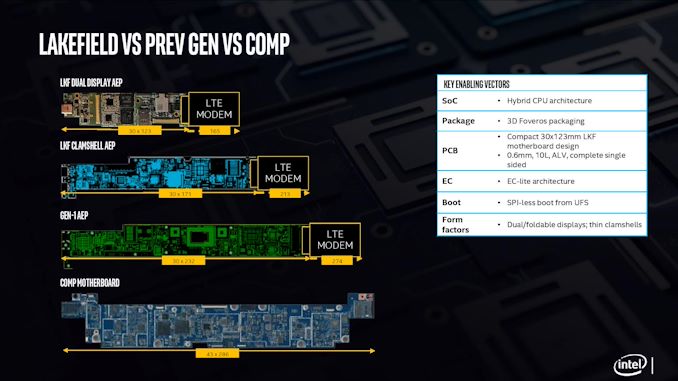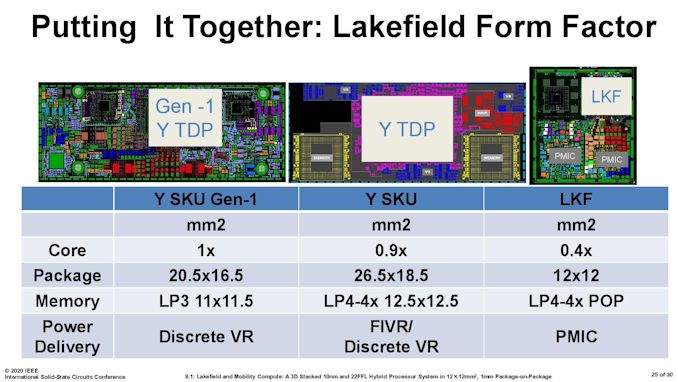The Intel Lakefield Deep Dive: Everything To Know About the First x86 Hybrid CPU
by Dr. Ian Cutress on July 2, 2020 9:00 AM ESTLakefield in Terms of Laptop Size
In a traditional AMD or Intel processor designed for laptops, we experience two to eight processing cores, along with some graphics performance, and it is up to the company to build the chip with the aim of hitting the right efficiency point (15 W, or 35/45 W) to enable the best performance for a given power window. These processors also contain a lot of extra connectivity and functionality, such as a dual channel memory controller, extra PCIe lanes to support external graphics, support for USB port connectivity or an external connectivity hub, or in the case of Intel’s latest designs, support for Thunderbolt built right into the silicon without the need for an external controller. These processors typically have physical dimensions of 150 square millimeters or more, and in a notebook, when paired with the additional power delivery and controllers needed such as Wi-Fi and modems, can tend towards the board inside the system (the motherboard) totaling 15 square inches total.

One of Qualcomm’s examples from 2018
For a Qualcomm processor designed for laptops, the silicon is a paired down to the essentials commonly associated with a smartphone. This means that modem connectivity is built into the processor, and the hardware associated with power delivery and USB are all on the scale of a smartphone. This means a motherboard designed around a Qualcomm processor will be around half the size, enabling different form factors, or more battery capacity in the same size laptop chassis.
With Intel’s new Lakefield processor design, the chip is a lot smaller than previous Intel implementations. The company designed the processor from the ground up, with as much included on the CPU as to not need additional chips on the motherboard, and to fit the dimensions similar to one of Qualcomm’s processors. Above is a slide showing how Intel believes that with an LTE modem included, a Lakefield motherboard can move down to 7.7 square inches, similar to a Qualcomm design. This leaves more room for battery inside a device.
When Intel compares it against its own previous low power CPU implementations, the company quotes a 60% decrease in overall board area compared to its first generation 4.5 W processors.
It is worth noting that for power delivery, Intel placed MIMCAPs inside the Lakefield silicon, much like a smartphone processor, and as a result it can get by on the power delivery implementation with a pair of PMICs (power management ICs). The reason why there is two is because of the two silicon dies inside – they are controlled differently for power for a number of technical reasons. If each layer within an active stacked implementation requires its own PMIC, that would presumably put an upper limit on future stacked designs – I fully expect Intel to be working on some sort of solution for this for it not to be an issue, however that wasn’t implemented in time for Lakefield.
For those that are interested, Lakefield’s PMICs are under the codenames Warren Cove and Castro Cover, and were developed in 2017-2018.












221 Comments
View All Comments
Valantar - Sunday, July 5, 2020 - link
Uhm, I have to ask, did you write this comment eight months ago? AMD has been kicking Intel's butt in 15W laptops since the first Renoir laptops hit the streets. While that did take a while after the initial presentation, their advantage is nonetheless significant both in performance and power draw.serendip - Monday, July 6, 2020 - link
AMD doesn't have anything in the 5W TDP range. Not yet, anyway. The problem is that Lakefield brings middling performance at a high price. Intel already has 5W and 4W parts, check out the Pentium 4425Y and m3-8100Y in the Surface Go 2. Those chips are much cheaper and easier to fab than Lakefield and they bring equal or higher performance.Kangal - Tuesday, July 7, 2020 - link
The best sku chipset that AMD makes in the "15W bracket" is the 4800U. However, that's with the TDP-down as it's not a proper 15W part. Plus, there are no laptops with that combination yet. The Lenovo Yoga Slim7 has the chipset, but it is at the 25W bracket, and apparently that goes much higher during use when possible.So no, AMD isn't quite kicking Intel's butt in the Ultrabook segment yet. Maybe in 6 months, when yields improve and more vendors join. But for now, Intel is still the dominant force in the Thin & Light segment. AMD they're killing it at the Regular Laptop market, the Entire Desktop Market, the Server market, and the Console market. However, ARM is pretty much going to take over the Server Market now that the big companies are moving that way, and since Linux drivers have matured on ARMv8_64. The laptop segment is safe for now, but the new Macs might cause other vendors to think beyond Windows, or think beyond x86. The Console segment and Desktop segments are safe for now (and for at least this decade).
Spunjji - Friday, July 10, 2020 - link
That's an arbitrary distinction if ever I saw one. By that definition, Ice Lake is a 28W part operating in "TDP down" to 15W.AMD could conceivably laser 4 cores and 60% of the GPU off a Renoir chip, drop the clocks and end up with a "5W" part not dissimilar to Intel's M3 series. It wouldn't make any sense for them to do so, though, because they can't make enough chips as it is and it wouldn't really buy them any meaningful market share.
Kangal - Friday, July 10, 2020 - link
I didn't discount the 4800U at all. I merely stated the fact that it is, in fact, a 25W chipset and it can operate at 15W with TDP-down. I'm not sure you quite understand this tier system.But anyways, my point was that AMD's best 15W option is the 4800U, but we don't know how it actually performs because there are no devices out there. From what we can speculate, it should be very competitive, but Intel really has championed the Ultrabook market in the last decade. So for all intents and purposes, Intel is probably still ahead here by a hair, yet they could've had a larger lead if they implemented the above design I tried to explain. Too bad. AMD will humiliate/supersede them completely in a year or two at this pace.
Spunjji - Monday, July 6, 2020 - link
"And AMD would struggle to fit those technologies into a 8-core laptop processor, so there would be no threat from above."Boy, you really need to keep up with the news...
Kangal - Tuesday, July 7, 2020 - link
No, you didn't read that correctly.AMD doesn't have any 8-core processor on their 16nm/14nm/12nm node, that is, confined to the thermal profile of a laptop. I was saying Intel needed to release the processor that I outlined, and release it years ago. And if they did that, then their only competition would be Renoir/Ryzen-4000, and even then AMD would lose on the low-voltage (Ultrabook) market and win on the regular (Laptop) market.
See the above comment by serendip. AMD is working on having lower and lower voltage chips. Their lowest power one I think is still the V1605B embedded chip. But right now, that small company is really stretched thin. They're working on Servers, on HDD optimisations, on making GPUs, on optimising GPUs, on making console processors, on desktops, laptops, and a few other budget options.
By the time AMD actually properly polishes the driverset for laptops/battery drain, it's going to be another year. But hopefully, on the next set of chips they update the graphics (from Vega to RDNA). It's possible they might ditch the monolithic design of their mobile chips, and shift those over to a chiplet design as well. This will take a hit to performance, and to efficiency... but on the bright side it should mean even cheaper processors to vendors and consumers-alike.
Spunjji - Friday, July 10, 2020 - link
I think I understand now, but the phrasing was confusing!eastcoast_pete - Thursday, July 2, 2020 - link
It's beyond embarrassing, it's borderline idiotic. Intel's "performance" cores have one unique differentiator going for them, and that is the ability to execute AVX, especially AVX2 and AVX512 instructions. Doing what they did means they basically gelded their own big core, and this gelding won't win any performance crowns.I sort of get why it's hard to have a scheduler trying to work with cores that have different capabilities, but is it really impossible to have one that makes it a hard and fast rule that if an AVX instruction is called for, the big core gets fired up? Now, I am not able to program one of these myself, but, as a user, I would rather pay a little power consumption penalty and have a real Sunny Cove-like large core than an overgrown Atom as the "performance" core. Big mistake.
brantron - Thursday, July 2, 2020 - link
The trouble with AVX on the Sunny Cove core is it will still only be one core.So add another, and call it...Ice Lake Y? Wait a minute... :p
After more than a decade, Atom for PC still looks like a square peg in a round hole.